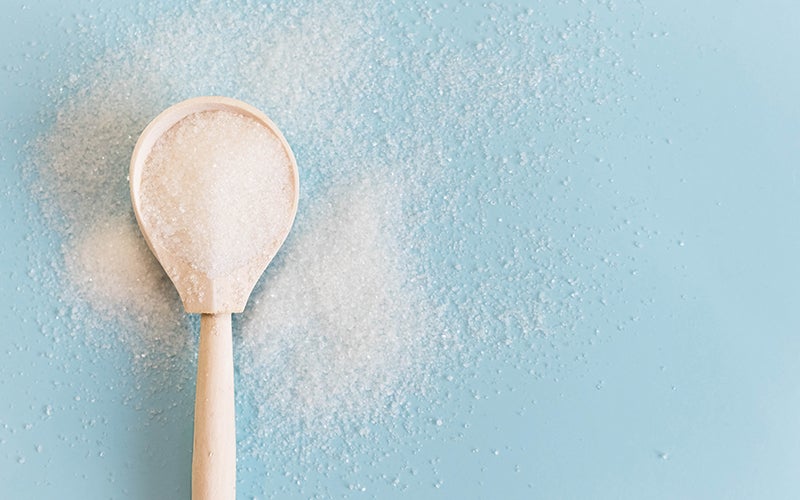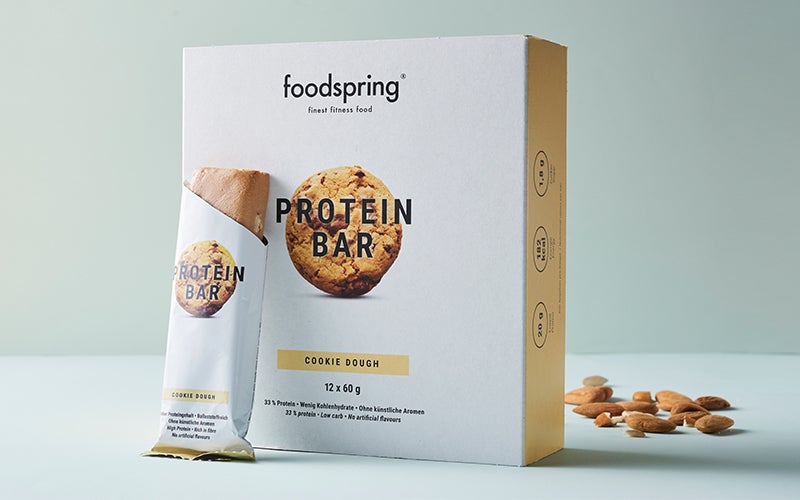Xylitol: What is this sugar substitute, and where does it shine?
 ©Quanthem
©Quanthem
We don’t think it’s likely that all of us want to give up that little bit of sweetness in life. And if you’ve been looking to satisfy a craving without the calories, you might have already stumbled upon xylitol. It could also be the key to meeting your nutrition goals. What’s this popular sugar alternative really all about? Let’s find out…
What Is Xylitol?
In your search for natural and low-calorie sugar alternatives, sooner or later you’ll probably come across xylitol, also known as birch sugar. The two terms may sound nothing alike, but they do refer to the same product.
Xylitol falls into the group of sugar substitutes (its European Union code is E 967, which makes it easy to find on labels) steadily climbing the food industry’s popularity scale – while classic table sugar is continuing to fall. These sugar alternatives are said to have several advantages over the standard sweetener. But more about that later!
Xylitol is a naturally occurring sugar alcohol found in some vegetables and fruits such as cauliflower and strawberries. It’s also found in the bark of certain trees like birches, which explains its other name.
That brings us to the next point. Although xylitol’s origin is natural, it’s produced chemically. Because this process is quite complex, xylitol isn’t all that cheap. And despite its other name, xylitol isn’t usually made from birch wood – agricultural byproducts such as hardwoods, straw, and corn cobs are often the raw material used.
In the meantime, xylitol is literally on everyone’s lips and has definitely made a name for itself because of its relatively low calorie content. That’s also why xylitol has become an essential ingredient in nutrition plans for fitness. Want to balance taking care of your health with the need for a bit of sweetness in your diet? Use this sugar alcohol in your favorite recipes for cakes and cookies, and get baking!
Xylitol is commonly available as a sugar substitute in powder form. But it can also be found in many ready-made foods – including low-calorie, sugar-free products such as snacks, spreads, chewing gum, candy, drinks, and sauces.
Xylitol Calories and Nutritional Values
Xylitol is much lower in calories than table sugar. One gram contains just two calories! But you’ll look in vain for other nutrients like vitamins, minerals, fiber, fats, and such in xylitol – which isn’t a big surprise given that it’s just a sweetener.
What makes it really special, however, is that xylitol, like all sugar alcohols, cannot be completely metabolized by your body, which is why it has a lower calorie value.
Does Xylitol Have Advantages Over Sugar?
Xylitol definitely has the edge when it comes to calories since 100 grams of xylitol has 236 calories while 100 grams of white sugar contains 450 calories. No wonder baking with this substitute is healthier!
Don’t worry if the recipes you want to use are based on traditional sugar. Xylitol has the same sweetening power as the classic, as well as a similar consistency and taste, and can easily replace it one to one. The annoying conversion calculations needed for other sweeteners are a thing of the past!
But sugar isn’t just full of calories, it’s also bad for your teeth, because it can cause cavities and tooth decay. With xylitol, on the other hand, you don’t need to worry about your radiant smile. Xylitol’s advantage comes from the fact that the bacteria that cause cavities don’t process sugar alcohols well. Some studies have even observed a decrease in tooth decay in connection with xylitol use. This is also what makes chewing gum and lozenges containing xylitol such a good choice.
Xylitol has one other key advantage: it only has a small effect on your blood sugar and insulin levels, and its metabolism is insulin-independent. This makes xylitol particularly useful for diabetics.
Possible Side Effects: Is Xylitol Carcinogenic?
Xylitol sounds almost too good to be true. So does it have some hidden, long-term effect on human health?
Don’t worry, both Cancer Research UK and the US National Cancer Institute say that all sweeteners approved so far, including xylitol, are safe for humans.
Only one significant side effect of xylitol has been observed in the research thus far: If consumed in excess, it can cause both gas and diarrhea. That’s why the maximum recommended daily amount is 0.5 grams of xylitol per kilo of body weight.
At this point we should also say that the body has to get used to xylitol at first. These unpleasant symptoms can be worse when you switch from sugar to xylitol all at once, so you should start with small amounts, like xylitol in gum. People who already have sensitive gastrointestinal tracts, however, should probably refrain from using it all.
For other mammals, xylitol can be life-threatening. It’s especially toxic to dogs because they lack an enzyme in the liver that helps break down xylitol. So if you’re a dog owner and baking with xylitol, make sure that nothing accidentally falls on the floor.
Pay Attention to This When Buying Xylitol
We’ve noticed that more and more shops are adding xylitol to their shelves. But if you can’t find it in regular supermarkets, try health food stores, drugstores, or organic food stores. There’s also a wide range of xylitol products online.
What should you look out for when buying xylitol? As with other products, it’s worth taking a closer look, especially at the info about production and origin. For example, since xylitol can be made from corn residues, you should make sure that the corn hasn’t been genetically modified. Basically, look through the information provided by the manufacturer and compare it with others to make sure you’re choosing a high-quality product.
Is leaving the smallest possible ecological footprint also important to you? Then xylitol products from locations close to home are the better choice.
Baking with Xylitol – An Overview
Since xylitol can be exchanged one-to-one for sugar and is also heat stable, there is nothing keeping you from using this sweetener in your next baking session. Plus: it dissolves even better warm than cold.
Let your imagination run wild and use xylitol in any recipe that calls for sugar! There’s only one spoilsport you need to watch out for, and that’s yeast. Yeast can’t metabolize xylitol so your dough won’t rise as well. But there’s plenty of other possibilities!
Want to start right away and treat yourself to something sweet without the guilt? Then take a look at our recipes section and choose your favorite sweet snack to make!
Our tip: Not in the mood for baking? Check out our Cookie Dough Protein Bar! Tastes as delicious as a cookie, with no artificial flavors or added sugar. Sounds like a perfect snack to us!

Conclusion
- Xylitol is a sugar substitute with half the calories of refined sugar.
- Why is it so popular? Xylitol has fewer calories than sugar, it’s better for your teeth, and only has a minor effect on blood sugar and insulin levels.
- Beware of eating too much xylitol because it could cause gas and diarrhea.
- Xylitol is heat stable and therefore suitable as a sugar substitute in baking.
- Recipes calling for traditional sugar are easy to adapt because it can be replaced one to one with xylitol.
Sources for this article
We at foodspring use only high-quality sources, including peer-reviewed studies, to support the facts within our articles. Read our editorial policy to learn more about how we fact-check and keep our content accurate, reliable, and trustworthy.
- Verbraucherzentrale (2019): Kokosblüten-, Birkenzucker, Stevia & Co. kein sinnvoller Zuckerersatz https://www.verbraucherzentrale.de/wissen/lebensmittel/schlankheitsmittel-und-diaeten/kokosblueten-birkenzucker-stevia-co-kein-sinnvoller-zuckerersatz-13370
- Nährwertrechner.de https://www.naehrwertrechner.de/naehrwerttabelle/
- DGE (2014): DGE-BW-Forum Süßungsmittel https://www.dge-bw.de/files/dge-bw/uploads-files/PDFs-DGE/dokumentationsband_sungsmittel_2014.pdf
- BfR (2014): Bewertung von Süßstoffen und Zuckeraustauschstoffen https://www.bfr.bund.de/cm/343/bewertung_von_suessstoffen.pdf
- Deutsches Krebsforschungszentrum (2020): Lebensmittelzusatzstoffe und Süßstoffe https://www.krebsinformationsdienst.de/vorbeugung/risiken/lebensmittelzusatzstoffe.php
- Chemie.de (2020): Xylitol https://www.chemie.de/lexikon/Xylitol.html
- Chemie.de (2020): Zuckeraustauschstoffe https://www.chemie.de/lexikon/Zuckeraustauschstoffe.html





























